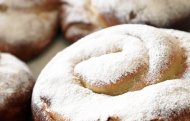Spanish Desserts

Breakfast and Merienda
But Spanish sweet treats do not restrict themselves to desserts. The long, slender, crisp fritters known as churros are irresistible treats that never appear on a dessert menu., but are eaten for breakfast all over Spain. Majorcan ensaimadas, fluffy pastry coils that are sometimes plain and sometimes filled with preserves or cream, are also enjoyed as the first meal of the day. Both the fritters and the pastries are eaten for merienda, the Spanish teatime, too, serving as perfect mid-afternoon pick-me-ups in anticipation of the long wait for Spain's legendary late dinner hour.
Ensaimada (Majorcan Sweet bread): A Majorcan favorite, ensaimadas are warm, yeast-based cakes fashioned into round, coiled shapes. Although delicious, these cakes are time-consuming to prepare, because the dough must be allowed to rise several times.
Andalusia is famous for its mermelada de naranja ácida, yet another breakfast-table favorite. The marmalade, made form the region's bitter Seville oranges, is delicious spread on the day's first bread. In contrast, the popular, mildly floral-tasting preserve known as carne de, or quince paste, is typically served after dinner with Spanish cheese, with a slice of each placed together on a plate. Apart from these two - orange marmalade and membrillo - Spaniards enjoy the products of their rich agriculture all year-round with excellent fruit preserves, such as raspberry, , plum, strawberry, or wild blackberry.
Mermelada de naranja ácida: England has long been recognized as the source of some of the world’s best orange marmalade. Until recently, the bitter oranges the English used were grown in the public parks and streets of Sevilla. Picking oranges from the city’s orange trees was strictly forbidden, and fines were handed out to those who dared take the precious fruits. The entire harvest was shipped to England by virtue of a contract between the municipality of Sevilla and major English marmalade producers. Occasionally, an officer could be bribed to look the other way while five or six oranges were picked, which is just the amount needed to make this recipe.
Cabello de ángel - Spanish Pumpkin preserve: The long, yellow fibers inside a pumpkin likely account for the name of this preserve, cabello de ángel, or “angel’s hair.” Whatever the origin of the name, this wonderful preserve is popular all over Spain. It is mainly used as a filling for turnovers like robiols, pastries like ensaimadas, cakes, and other sweets.
developmentally appropriate practice education course top gofundme campaigns 2022 startup funding website united nations purpose moecs entrepreneurship ideas for students morgan stanley multicultural innovation lab iit courses philippine entrepreneurs enterprise deer park icar e course cna classes near me ikon education european regional development fund general education computer science degree cloud funding platformSource: www.spain-recipes.com
Related posts:








